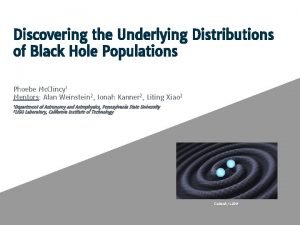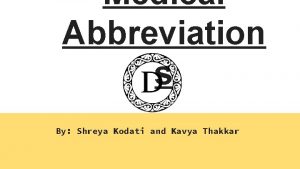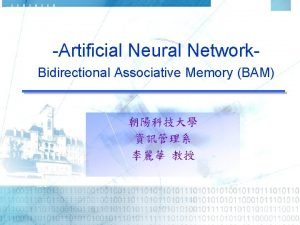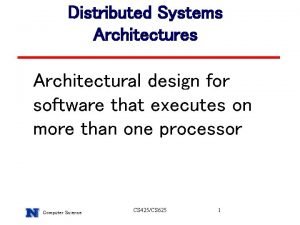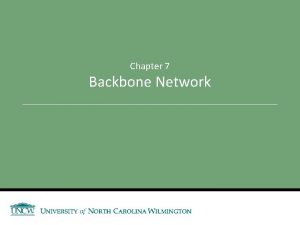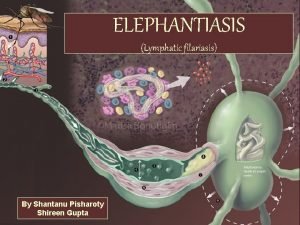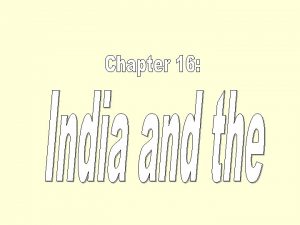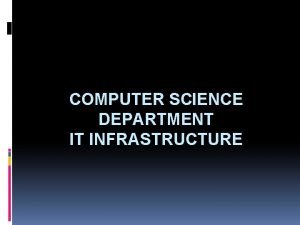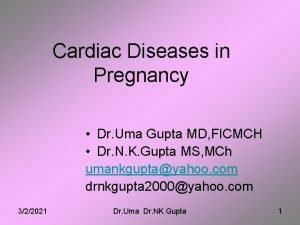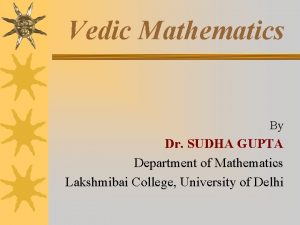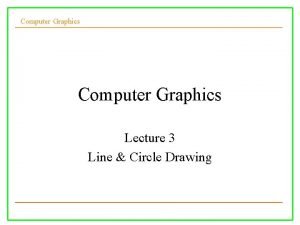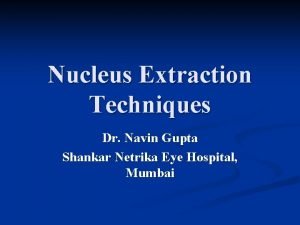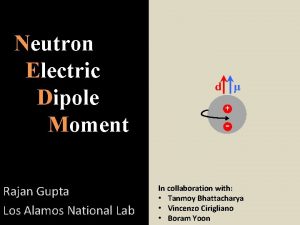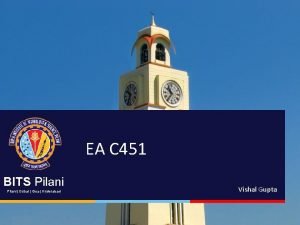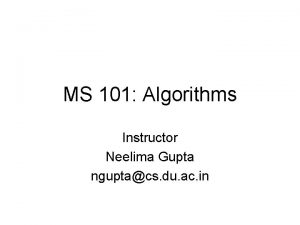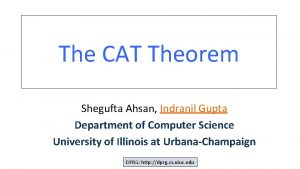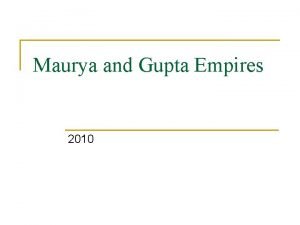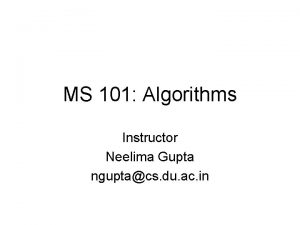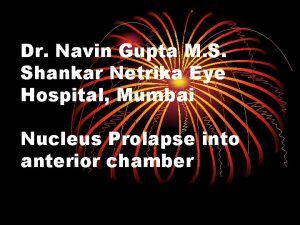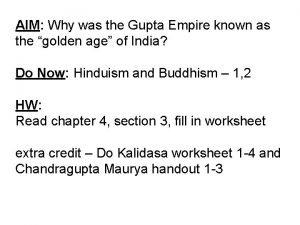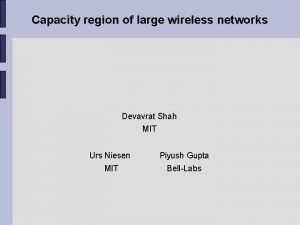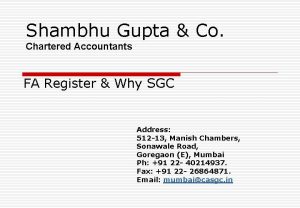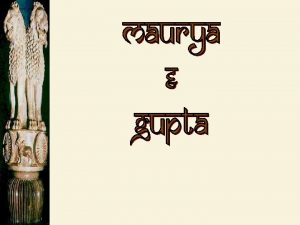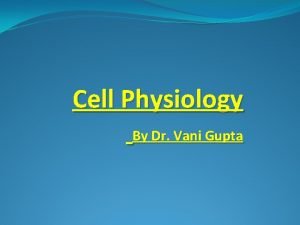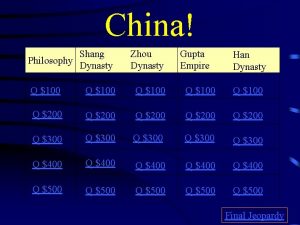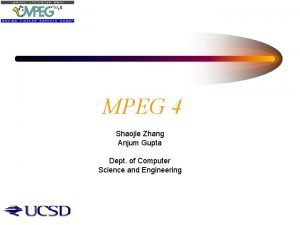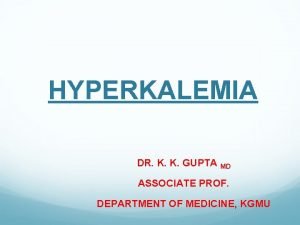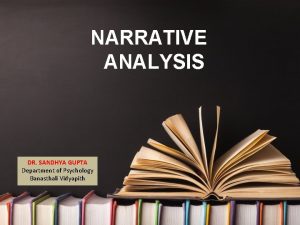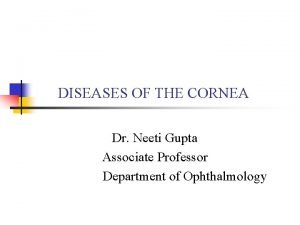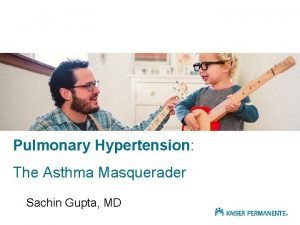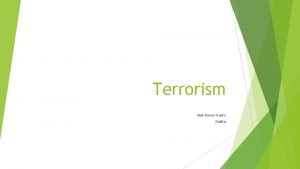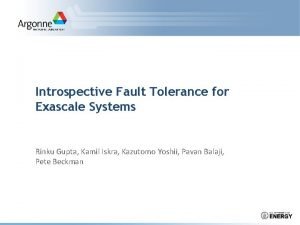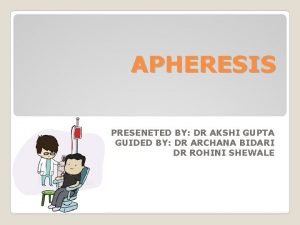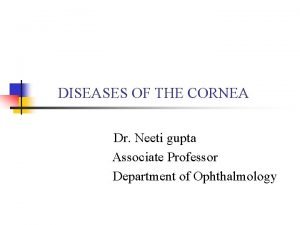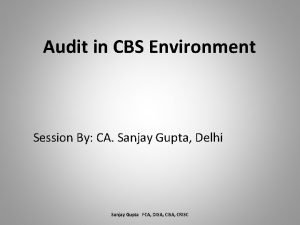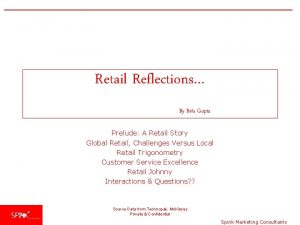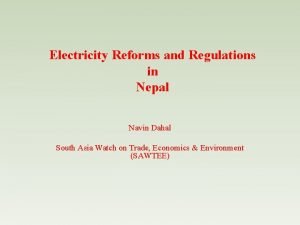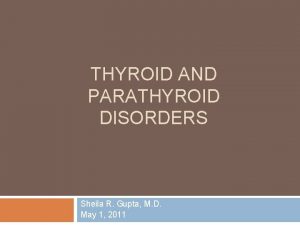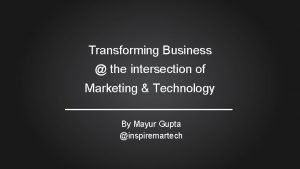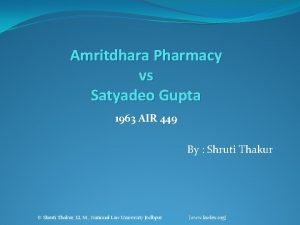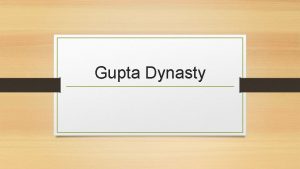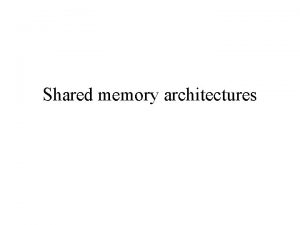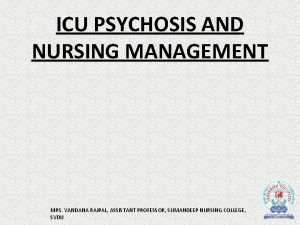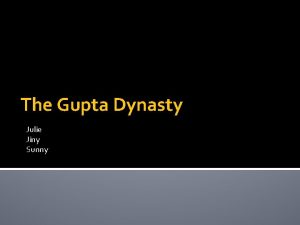Neural Architectures with Memory Nitish Gupta Shreya Rajpal

























































































- Slides: 89

Neural Architectures with Memory Nitish Gupta, Shreya Rajpal 25 th April, 2017 1

Story Comprehension Joe went to the kitchen. Fred went to the kitchen. Joe picked up the milk. Joe travelled to his office. Joe left the milk. Joe went to the bathroom. Questions from Q 1 : Where is Joe’s angry Joe? mother: Q 2 : Where is the milk now? Q 3 : Where was Joe before the office? 2

Hello! What can I do for you today? I’d like to reserve a table for 6. Sure! When would you like that reservation? At 7 PM, please. Okay. What cuisine would you like? Actually make that 7: 30 PM Updated! What cuisine? Is there anything better than a medium rare steak? Nothing at all! Blackdog has a 4. 7 on Yelp. Sounds perfect! Also, add one more person. Reservation done for 7, 7: 30 pm at Blackdog. Enjoy! 3 Human Machi ne Dialogue System

ML models need memory! Deeper AI tasks require explicit memory and multi-hop reasoning over it • RNNs have short memory • Cannot increase memory without increasing number of parameters • Need for compartmentalized memory • Read/Write should be asynchronous 4

Memory Networks (Mem. NN) • Each memory here is a dense vector Memory Networks, Weston et. al. , ICLR 2015 5

Mem. NN • Memory Networks, Weston et. al. , ICLR 2015 6

Mem. NN • Memory Networks, Weston et. al. , ICLR 2015 7

Simple Mem. NN for Text 1. Input Feature Map - Bag-of-Words representation Sentence Bag-of-Words Memory Networks, Weston et. al. , ICLR 2015 8

Simple Mem. NN for Text 2. Generalization : Store input in new memory Memories till now (i=4) Memory Networks, Weston et. al. , ICLR 2015 Memories after 5 inputs 9

Simple Mem. NN for Text • Score all memories against input 1 st Max scoring memory index 2 nd Max scoring memory index Score all words against query and 2 supporting memories Max scoring word Memory Networks, Weston et. al. , ICLR 2015 10

Scoring Function • Scoring Function is an embedding model Scoring Function is just dot-product between sum of word embeddings!!! Memory Networks, Weston et. al. , ICLR 2015 11

Joe went to the kitchen. Fred went to the kitchen. Joe picked up the milk. Joe travelled to his office. Joe left the milk. Joe went to the bathroom. Input Sentences Where is the milk now? Question Memories 1 st supporting memory 2 nd supporting memory Offic e Response Where is the milk now? Question Memory Networks, Weston et. al. , ICLR 2015 12

Training Objective Score for true 1 st memory Memory Networks, Weston et. al. , ICLR 2015 Score for a negative memory 13

Training Objective Score for true 2 nd memory Memory Networks, Weston et. al. , ICLR 2015 Score for a negative memory 14

Training Objective Score for true response Memory Networks, Weston et. al. , ICLR 2015 Score for a negative response 15

Experiment Stored as memories • Output is highest scoring memory Method F 1 Fader et. al. 2013 0. 54 Bordes et. al. 2014 b 0. 73 Memory Networks (This work) 0. 72 Why does Memory Network perform exactly as previous model? Memory Networks, Weston et. al. , ICLR 2015 16

Experiment T N E M • E S S E L P X Method Fader et. al. 2013 I R E F 1 0. 54 Bordes et. al. 2014 b 0. 73 Memory Networks (This work) 0. 72 E S U Why does Memory Networks not perform as well? 17

Useful Experiment • Memory Networks, Weston et. al. , ICLR 2015 18

Limitations • Simple BOW representation • Simulated Question Answering dataset is too trivial • Strong supervision i. e. for intermediate memories is needed Memory Networks, Weston et. al. , ICLR 2015 19

End-to-End Memory Networks (Mem. N 2 N) • Joe went to the kitchen. Fred went to the kitchen. Joe picked up the milk. Joe travelled to his office. Joe left the milk. Joe went to the bathroom. Where is the milk now? Offi ce End-To-End Memory Networks, Sukhbaatar et. al. , NIPS 2015 20

Mem. N 2 N • BOW input Sum of wordembeddings Word-Embedding Matrix End-To-End Memory Networks, Sukhbaatar et. al. , NIPS 2015 21

Mem. N 2 N 3. Scoring memories against query Memories Score for input/memory Query (transformed) 4. Generate output Weighted average of all inputs (transformed) End-To-End Memory Networks, Sukhbaatar et. al. , NIPS 2015 22

Mem. N 2 N 5. Generating Response Distribution over response words Query Averaged-output Training Objective – Maximum Likelihood / Cross Entropy End-To-End Memory Networks, Sukhbaatar et. al. , NIPS 2015 23

Score memories Make averaged output Response Generate outputs Generate memories Transform Query End-To-End Memory Networks, Sukhbaatar et. al. , NIPS 2015 24

Multi-hop Mem. N 2 N Hop 3 Hop 2 Different Memories and Outputs for each Hop 1 End-To-End Memory Networks, Sukhbaatar et. al. , NIPS 2015 25

Experiments • Simulated World QA • 20 Tasks from b. Ab. I dataset - 1 K and 10 K instances per task • Vocabulary = 177 words only!!!!! • 60 epochs • Learning Rate annealing • Linear Start with different learning rate • “Model diverged very often, hence trained multiple models” End-To-End Memory Networks, Sukhbaatar et. al. , NIPS 2015 26

Mem. NN Mem. N 2 N Error % (1 k) 6. 7 12. 4 Error % (10 k) 3. 2 7. 5 End-To-End Memory Networks, Sukhbaatar et. al. , NIPS 2015 27

Movie Trivia Time! Subject • Which was Stanley Kubricks’s first movie? Fear and Desire • When did 2001: A Space Odyssey release? 1968 • After The Shining, which movie did its director direct? Full Metal Jacket Relation Object (2001: a_space_odyssey, directed_by, stanley_kubrick) (fear_and_dark, directed_by, stanley_kubrick) … (fear_and_dark, released_in, 1953) (full_metal_jacket, released_in, 1987) … (2001: a_space_odyssey, released_in, 1968) … (the_shining, directed_by, stanley_kubrick) … (AI: artificial_intelligence, written_by, stanley_kubrick) Knowledge Base 28

Knowledge Base? Textual Knowledge? (2001: a_space_odyssey, directed_by, stanley_kubrick) (fear_and_dark, directed_by, stanley_kubrick) … (fear_and_dark, released_in, 1953) (full_metal_jacket, released_in, 1987) … (2001: a_space_odyssey, released_in, 1968) … (the_shining, directed_by, stanley_kubrick) … (AI: artificial_intelligence, written_by, stanley_kubrick) Incomplete! Too Challenging! Combine using Memory Networks? 29

Key-Value Mem. NNs for Reading Documents • Structured Memories as Key-Value Pairs • Regular Mem. NNs have single vector for each memory • Key more related to question and values to answer Keys and Values can be Words, Sentences, Vectors etc. Key-Value Memory Networks for Directly Reading Documents, Miller et. al. , EMNLP 2016 30

KV-Mem. NN 1. Retrieve relevant memories using Hashing Techniques Retrieved Relevant Memories All Memories Use inverted index, locality sensitive hashing, something sensible Key-Value Memory Networks for Directly Reading Documents, Miller et. al. , EMNLP 2016 31

KV-Mem. NN 2. Score Memory-Keys Distribution over Memory-Keys Key Dot-Prod Sum of Embeddings BOW 3. Generate Output Weighted average of Memory-values Key-Value Memory Networks for Directly Reading Documents, Miller et. al. , EMNLP 2016 32

KV-Mem. NN - Multiple Hops Key Addressing Generate Response Final Hop Key-Value Memory Networks for Directly Reading Documents, Miller et. al. , EMNLP 2016 33

KV-Mem. NN – What to store in memories? 1. KB Based : Key: (subject, relation); Value: Object K: (2001: a_space_odyssey, directed_by); V: stanley_kubrick 2. Document Based For each entity in document, extract 5 -word window around it Key: window; Value: Entity K: screenplay written by and; V: Hampton Key-Value Memory Networks for Directly Reading Documents, Miller et. al. , EMNLP 2016 34

KV-Mem. NN – Experiments • Wiki. Movies Benchmark • • Total 100 K QA-pairs 10% for testing Method KB Doc E 2 E Memory Network 78. 5 69. 9 Key-Value Memory Network 93. 9 76. 2 Key-Value Memory Networks for Directly Reading Documents, Miller et. al. , EMNLP 2016 35

KV-Mem. NN Score relevant Memory-Keys Retrieve relevant Memories Generate Output using Averaged Memory-Values Generate Response Key-Value Memory Networks for Directly Reading Documents, Miller et. al. , EMNLP 2016 36

KV-Mem. NN Key-Value Memory Networks for Directly Reading Documents, Miller et. al. , EMNLP 2016 37

RNN CNN : Computer Vision : : ____ : NLP Key-Value Memory Networks for Directly Reading Documents, Miller et. al. , EMNLP 2016 38

Dynamic Memory Networks – The Beast Use RNNs, specifically GRUs for every module Ask Me Anything: Dynamic Memory Networks for Natural Language Processing, Kumar et. al. ICML 2016 39

DMN Ask Me Anything: Dynamic Memory Networks for Natural Language Processing, Kumar et. al. ICML 2016 40

DMN Ask Me Anything: Dynamic Memory Networks for Natural Language Processing, Kumar et. al. ICML 2016 41

DMN Ask Me Anything: Dynamic Memory Networks for Natural Language Processing, Kumar et. al. ICML 2016 42

DMN Ask Me Anything: Dynamic Memory Networks for Natural Language Processing, Kumar et. al. ICML 2016 43

DMN Ask Me Anything: Dynamic Memory Networks for Natural Language Processing, Kumar et. al. ICML 2016 44

DMN Ask Me Anything: Dynamic Memory Networks for Natural Language Processing, Kumar et. al. ICML 2016 45

DMN How many GRUs were used with 2 hops? Ask Me Anything: Dynamic Memory Networks for Natural Language Processing, Kumar et. al. ICML 2016 46

DMN – Qualitative Results Ask Me Anything: Dynamic Memory Networks for Natural Language Processing, Kumar et. al. ICML 2016 47

Algorithm Learning 48

Neural Turing Machine Copy Task: Implement the Algorithm Given a list of numbers at input, reproduce the list at output Neural Turing Machine Learns: 1. 2. 3. 4. 5. What to write to memory When to stop writing Which memory cell to read from How to convert result of read into final output 49

Neural Turing Machines External Input External Output Controller ‘Blurry’ Write Heads Read Heads Memory Neural Turing Machines, Graves et. al. , ar. Xiv: 1410. 5401 50

Neural Turing Machines ‘Blurry’ Memory Addressing (at time instant ‘t’) Mt Soft Attention (Lectures 2, 3, 20, 24) N wt wt(0) = 0. 1 wt(1) = 0. 2 wt(2) = 0. 5 wt(3) = 0. 1 wt(4) = 0. 1 M Neural Turing Machines, Graves et. al. , ar. Xiv: 1410. 5401 51

Neural Turing Machines More formally, Blurry Read Operation Given: Mt (memory matrix) of size Nx. M wt (weight vector) of length N t (time index) Neural Turing Machines, Graves et. al. , ar. Xiv: 1410. 5401 52

Neural Turing Machines: Blurry Writes Blurry Write Operation Decomposed into blurry erase + blurry add Given: Mt (memory matrix) of size Nx. M wt (weight vector) of length N t (time index) et (erase vector) of length M at (add vector) of length M Erase Component Neural Turing Machines, Graves et. al. , ar. Xiv: 1410. 5401 Add Component 53

Neural Turing Machines: Erase 1 x. N w 1(0) = 0. 1 w 1(1) = 0. 2 w 1(2) = 0. 5 w 1(3) = 0. 1 w 1(4) = 0. 1 M 0 e 1 5 7 9 2 12 1. 0 11 6 3 1 2 0. 7 3 10 6 0. 2 4 2 5 9 9 0. 5 3 5 12 8 4 0. 0 Neural Turing Machines, Graves et. al. , ar. Xiv: 1410. 5401 Mx 1 54

Neural Turing Machines: Erase w 1(0) = 0. 1 w 1(1) = 0. 2 w 1(2) = 0. 5 w 1(3) = 0. 1 w 1(4) = 0. 1 4. 5 5. 6 4. 5 1. 8 10. 23 5. 16 1. 95 0. 93 1. 86 2. 94 6. 72 2. 7 9. 8 5. 88 3. 8 1. 8 3. 75 8. 55 3 5 12 8 4 Neural Turing Machines, Graves et. al. , ar. Xiv: 1410. 5401 55

Neural Turing Machines: Addition w 1(0) = 0. 1 w 1(1) = 0. 2 w 1(2) = 0. 5 w 1(3) = 0. 1 w 1(4) = 0. 1 a 1 4. 5 5. 6 4. 5 1. 8 10. 8 3 10. 23 5. 16 1. 95 0. 93 1. 86 4 2. 94 6. 72 2. 7 9. 8 5. 88 -2 3. 8 1. 8 3. 75 8. 55 0 3 5 12 8 4 2 Neural Turing Machines, Graves et. al. , ar. Xiv: 1410. 5401 56

Neural Turing Machines: Blurry Writes M 1 4. 8 6. 2 6 2. 1 11. 1 10. 63 5. 96 3. 95 1. 33 2. 26 2. 74 6. 32 1. 7 9. 6 5. 68 3. 8 1. 8 3. 75 8. 55 3. 2 5. 4 13 8. 2 4. 2 Neural Turing Machines, Graves et. al. , ar. Xiv: 1410. 5401 57

Neural Turing Machines: Demonstration: Training on Copy Task Figure from Snips AI's Medium Post Neural Turing Machines, Graves et. al. , ar. Xiv: 1410. 5401 58

Neural Turing Machines: Attention Model Generating wt Content Based Location Based Example: QA Task Example: Copy Task - Score sentences by similarity with Question - Weights as softmax of similarity scores - Move to address (i+1) after writing to index (i) - Weights ≈ Transition probabilities Neural Turing Machines, Graves et. al. , ar. Xiv: 1410. 5401 59

Neural Turing Machine: Attention Model Steps for generating wt Prev. State 1. 2. 3. 4. 5. Controller Outputs Content Addressing Peaking Interpolation Convolutional Shift (Location Addressing) Sharpening CA I CS S Neural Turing Machines, Graves et. al. , ar. Xiv: 1410. 5401 60

Neural Turing Machine: Attention Model Prev. State : Vector (length M) produced by Controller Outputs Neural Turing Machines, Graves et. al. , ar. Xiv: 1410. 5401 61

Neural Turing Machine: Attention Model Prev. State Step 1: Content Addressing (CA) Controller Outputs CA Neural Turing Machines, Graves et. al. , ar. Xiv: 1410. 5401 62

Neural Turing Machine: Attention Model Prev. State Step 2: Peaking Controller Outputs CA Neural Turing Machines, Graves et. al. , ar. Xiv: 1410. 5401 63

Neural Turing Machine: Attention Model Prev. State Step 3: Interpolation (I) Controller Outputs CA I Neural Turing Machines, Graves et. al. , ar. Xiv: 1410. 5401 64

Neural Turing Machine: Attention Model Prev. State Step 4: Convolutional Shift (CS) • Controller outputs , a normalized distribution over all N possible shifts • Rotation-shifted weights computed as: Controller Outputs CA I CS Neural Turing Machines, Graves et. al. , ar. Xiv: 1410. 5401 65

Neural Turing Machine: Attention Model Prev. State Step 5: Sharpening (S) • Uses to sharpen as: Controller Outputs CA I CS S Neural Turing Machines, Graves et. al. , ar. Xiv: 1410. 5401 66

Neural Turing Machine: Controller Design • Feed-forward: faster, more transparency & interpretability about function learnt • LSTM: more expressive power, doesn’t limit the number of computations per time step Both are end-to-end differentiable! 1. Reading/Writing -> Convex Sums 2. wt generation -> Smooth 3. Controller Networks Neural Turing Machines, Graves et. al. , ar. Xiv: 1410. 5401 67

Neural Turing Machine: Network Overview Unrolled Feed-forward Controller Figure from Snips AI's Medium Post Neural Turing Machines, Graves et. al. , ar. Xiv: 1410. 5401 68

Neural Turing Machines vs. Mem. NNs • Memory is static, with focus on retrieving (reading) information from memory NTMs • Memory is continuously written to and read from, with network learning when to perform memory read and write 69

Neural Turing Machines: Experiments Task Network Size NTM w/ LSTM* LSTM Number of Parameters NTM w/ LSTM Copy 3 x 100 3 x 256 67 K 1. 3 M Repeat Copy 3 x 100 3 x 512 66 K 5. 3 M Associative 3 x 100 3 x 256 70 K 1. 3 M N-grams 3 x 100 3 x 128 61 K 330 K Priority Sort 2 x 100 3 x 128 269 K 385 K Neural Turing Machines, Graves et. al. , ar. Xiv: 1410. 5401 70

Neural Turing Machines: ‘Copy’ Learning Curve Trained on 8 -bit sequences, 1<= sequence length <= 20 Neural Turing Machines, Graves et. al. , ar. Xiv: 1410. 5401 71

NTM LSTM Neural Turing Machines: ‘Copy’ Performance Neural Turing Machines, Graves et. al. , ar. Xiv: 1410. 5401 72

Neural Turing Machines triggered an outbreak of Memory Architectures! 73

Dynamic Neural Turing Machines Experimented with addressing schemes • Dynamic Addresses: Addresses of memory locations learnt in training – allows non-linear location-based addressing • Least recently used weighting: Prefer least recently used memory locations + interpolate with content-based addressing • Discrete Addressing: Sample the memory location from the content-based distribution to obtain a one-hot address • Multi-step Addressing: Allows multiple hops over memory Results: b. Ab. I QA Task Location NTM Content NTM Soft DNTM Discrete DNTM 1 -step 31. 4% 33. 6% 29. 5% 27. 9% 3 -step 32. 8% 32. 7% 24. 2% 21. 7% Dynamic Neural Turing Machine with Soft and Hard Addressing Schemes, Gulchere et. al. , 74 ar. Xiv: 1607. 00036

Stack Augmented Recurrent Networks Learn algorithms based on stack implementations (e. g. learning fixed sequence generators) Uses a stack data structure to store memory (as opposed to a memory matrix) Inferring Algorithmic Patterns with Stack-Augmented Recurrent Nets, Joulin et. al. , ar. Xiv: 1503. 01007 75

Stack Augmented Recurrent Networks • Blurry ‘push’ and ‘pop’ on stack. E. g. : • Some results: Inferring Algorithmic Patterns with Stack-Augmented Recurrent Nets, Joulin et. al. , ar. Xiv: 1503. 01007 76

Differentiable Neural Computers Advanced addressing mechanisms: • Content Based Addressing • Temporal Addressing • Maintains notion of sequence in addressing • Temporal Link Matrix L (size Nx. N), L[i, j] = degree to which location I was written to after location j. • Usage Based Addressing Hybrid computing using a neural network with dynamic external memory, Graves et. al. , Nature vol. 538 77

DNC: Usage Based Addressing • Writing increases usage of cell, reading decreases usage of cell • Least used location has highest usage-based weighting • Interpolate b/w usage & content based weights for final write weights Hybrid computing using a neural network with dynamic external memory, Graves et. al. , Nature vol. 538 78

DNC: Example Hybrid computing using a neural network with dynamic external memory, Graves et. al. , Nature vol. 538 79

DNC: Improvements over NTMs NTM DNC • Large contiguous blocks of memory needed • Memory locations noncontiguous, usage-based • No way to free up memory cells after writing • Regular de-allotment based on usage-tracking Hybrid computing using a neural network with dynamic external memory, Graves et. al. , Nature vol. 538 80

DNC: Experiments Graph Tasks Graph Representation: (source, edge, destination) tuples Types of tasks: - Traversal: Perform walk on graph given source, list of edges - Shortest Path: Given source, destination - Inference: Given source, relation over edges; find destination Hybrid computing using a neural network with dynamic external memory, Graves et. al. , Nature vol. 538 81

DNC: Experiments Graph Tasks Training over 3 phases: • Graph description phase: (source, edge, destination) tuples fed into the graph • Query phase: Shortest path (source, ____, destination), Inference (source, hybrid relation, ___), Traversal (source, relation …, ___) • Answer phase: Target responses provided at output Trained on random graphs of maximum size 1000 Hybrid computing using a neural network with dynamic external memory, Graves et. al. , Nature vol. 538 82

DNC: Experiments Graph Tasks: London Underground Hybrid computing using a neural network with dynamic external memory, Graves et. al. , Nature vol. 538 83

DNC: Experiments Graph Tasks: London Underground Input Phase Hybrid computing using a neural network with dynamic external memory, Graves et. al. , Nature vol. 538 84

DNC: Experiments Graph Tasks: London Underground Traversal Task Query Phase Answer Phase Hybrid computing using a neural network with dynamic external memory, Graves et. al. , Nature vol. 538 85

DNC: Experiments Graph Tasks: London Underground Shortest Path Task Query Phase Answer Phase Hybrid computing using a neural network with dynamic external memory, Graves et. al. , Nature vol. 538 86

DNC: Experiments Graph Tasks: Freya’s Family Tree Hybrid computing using a neural network with dynamic external memory, Graves et. al. , Nature vol. 538 87

Conclusion • Machine Learning models require memory and multi-hop reasoning to perform AI tasks better • Memory Networks for Text are an interesting direction but very simple • Generic architectures with memory, such as Neural Turing Machine, limited applications shown • Future directions should be focusing on applying generic neural models with memory to more AI Tasks. Hybrid computing using a neural network with dynamic external memory, Graves et. al. , Nature vol. 538 88

Reading List • Karol Kurach, Marcin Andrychowicz & Ilya Sutskever Neural Random-Access Machines, ICLR, 2016 • Emilio Parisotto & Ruslan Salakhutdinov Neural Map: Structured Memory for Deep Reinforcement Learning, Ar. Xiv, 2017 • Pritzel et. al. Neural Episodic Control, Ar. Xiv, 2017 • Oriol Vinyals, Meire Fortunato, Navdeep Jaitly Pointer Networks, Ar. Xiv, 2017 • Jack W Rae et al. , Scaling Memory-Augmented Neural Networks with Sparse Reads and Writes, Ar. Xiv 2016 • Antoine Bordes, Y-Lan Boureau, Jason Weston, Learning End-to-End Goal. Oriented Dialog, ICLR 2017 • Junhyuk Oh, Valliappa Chockalingam, Satinder Singh, Honglak Lee, Control of Memory, Active Perception, and Action in Minecraft, ICML 2016 • Wojciech Zaremba, Ilya Sutskever, Reinforcement Learning Neural Turing Machines, Ar. Xiv 2016 89
 Shreya rajpal
Shreya rajpal Nitish khiria
Nitish khiria Gmail
Gmail Shreya anand caltech
Shreya anand caltech Kavya diviti
Kavya diviti Shreya notaney
Shreya notaney Shreya bhanushali
Shreya bhanushali Bidirectional associative memory example
Bidirectional associative memory example Integral and modular architecture
Integral and modular architecture Types of instruction set architecture
Types of instruction set architecture Autoencoders
Autoencoders Gpu cache coherence
Gpu cache coherence Cdn architectures
Cdn architectures Database storage architecture
Database storage architecture E business architecture
E business architecture Theo schlossnagle
Theo schlossnagle Why systolic architectures
Why systolic architectures Scalable web architectures
Scalable web architectures Ansi sparc
Ansi sparc Banking system architecture diagram
Banking system architecture diagram Gui architectures
Gui architectures Fundamental and incidental interactions
Fundamental and incidental interactions Three tier architecture of data warehouse
Three tier architecture of data warehouse Backbone network design
Backbone network design Backbone network architectures
Backbone network architectures Database system architectures
Database system architectures Implicit and explicit memory
Implicit and explicit memory Primary memory and secondary memory
Primary memory and secondary memory Virtual memory in memory hierarchy consists of
Virtual memory in memory hierarchy consists of Logical address
Logical address Long term memory vs short term memory
Long term memory vs short term memory Eidetic memory vs iconic memory
Eidetic memory vs iconic memory Which memory is the actual working memory?
Which memory is the actual working memory? Internal memory and external memory
Internal memory and external memory Shared vs distributed memory
Shared vs distributed memory Prototype in semantics
Prototype in semantics Virtual memory and cache memory
Virtual memory and cache memory Shireen gupta
Shireen gupta Fall of gupta empire
Fall of gupta empire Amit gupta microsoft
Amit gupta microsoft 647 ce
647 ce Odu linux servers
Odu linux servers Dr uma gupta
Dr uma gupta Dr sudha gupta
Dr sudha gupta Circle drawing algorithm in computer graphics
Circle drawing algorithm in computer graphics 647 ce
647 ce Shankar gupta
Shankar gupta P-cp
P-cp Vishal gupta bits pilani
Vishal gupta bits pilani Han gupta
Han gupta Neelima gupta delhi university
Neelima gupta delhi university Sujata gupta consultant gynaecologist
Sujata gupta consultant gynaecologist Dr indranil gupta
Dr indranil gupta Mauryan and gupta empire map
Mauryan and gupta empire map Kavita gupta md
Kavita gupta md Navin gupta md
Navin gupta md Varna gupta
Varna gupta Astronomy gupta empire
Astronomy gupta empire Pyloric stenosis
Pyloric stenosis Piyush gupta mit
Piyush gupta mit Shambhu gupta & co
Shambhu gupta & co Clamshell packaging design
Clamshell packaging design Dr abha gupta
Dr abha gupta Advantages of surface computing
Advantages of surface computing Mauryan empire and gupta empire venn diagram
Mauryan empire and gupta empire venn diagram Robert hooke
Robert hooke The maurya and gupta empires
The maurya and gupta empires Gupta empire philosophy
Gupta empire philosophy Vaani gupta
Vaani gupta Anjum gupta ucsd
Anjum gupta ucsd Dr kk gupta
Dr kk gupta Write the narration for gupta
Write the narration for gupta Oil droplet reflex
Oil droplet reflex Chd pulmonary hypertension
Chd pulmonary hypertension Alok gupta md
Alok gupta md Dr vinay gupta
Dr vinay gupta Gupta sculpture
Gupta sculpture Kamil gupta
Kamil gupta Kg technologies, inc.
Kg technologies, inc. Akshi gupta
Akshi gupta Neeti gupta
Neeti gupta Gupta outsourced
Gupta outsourced Audit in cbs environment
Audit in cbs environment Bela gupta
Bela gupta Vikram gupta md
Vikram gupta md Navin gupta
Navin gupta Harsh gupta md
Harsh gupta md Sheila gupta
Sheila gupta Patient wearable technology
Patient wearable technology Amritdhara pharmacy v. satyadeo gupta
Amritdhara pharmacy v. satyadeo gupta



